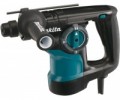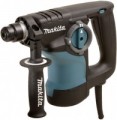Operating modes
— Drilling with impact. A mode of operation that combines rotation and percussive movement of the drill. Due to this, a complex effect on the treated surface is provided; in this case, the impact gives a direct advancement of the drill, and rotation is used primarily to remove the resulting waste. It is this format of work that allows you to effectively make holes in materials like concrete, brick, natural stone, etc .; at the same time, rotary hammers cope with such tasks much more efficiently than the so-called impact drills (drills supplemented with a chiseling function).
—
Drilling (without impact). Traditional drilling, when the hammer works like a drill: the working equipment only rotates, not moving back and forth. It is applied to work with rather soft materials, such as a tree and metal. At the same time, rotary hammers are often more efficient than traditional drills — due to the greater power and weight of the tool, they allow you to drill larger and deeper holes with sufficient accuracy.
—
Chiseling (demolition hammer). In this mode, the punch tool only moves back and forth, without rotation. This format of work can be useful when splitting large pieces of hard material, removing various coatings, etc. We emphasize that a rotary hammer, even a powerful and heavy one, will not replace a full-fledged demolition hammer; however, for relatively simple tasks — such as dismantling smal
...l structures made of relatively soft materials, splitting tiles, chasing walls, etc. — a tool with this mode is quite suitable.Impact energy
The energy transmitted by the perforator to the material being processed upon impact; the higher this indicator, the stronger and more powerful each individual blow.
First of all, we recall that the energy of impacts is directly related to their frequency: an increase in frequency leads to a decrease in energy. Therefore, for models where the number of strokes can be adjusted, this paragraph usually gives the maximum energy achieved at the minimum speed of operation.
In general, higher impact energy improves efficiency when working with hard, stubborn materials, but requires more motor power (especially if it has to be combined with a high frequency). Therefore, it is worth choosing according to this parameter, taking into account specific tasks. So, for occasional use in everyday life, an energy of 2 J or less is enough, for home repair work of medium intensity, at least 3 J is desirable; a power of
4 J or more is already considered high; and in some industrial-grade perforators, this figure can reach 30 J.
Max. hole saw ⌀
The maximum tool diameter that can be used with a rotary hammer when drilling with a hollow core. Crowns are used to create holes of large diameter (from 40 mm) in hard materials such as reinforced concrete and stone. See "Maximum drilling diameter in wood" for details on the maximum diameter.

